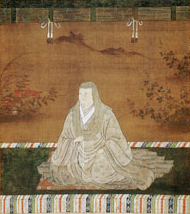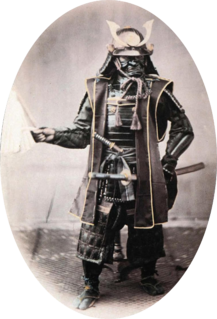
Oda Nobunaga was a powerful daimyō of Japan in the late 16th century who attempted to unify Japan during the late Sengoku period, and successfully gained control over most of Honshu. Nobunaga is regarded as one of three unifiers of Japan along with his retainers Toyotomi Hideyoshi and Tokugawa Ieyasu. During his later life, Nobunaga was widely known for most brutal suppression of determined opponents, eliminating those who by principle refused to cooperate or yield to his demands. His reign was noted for innovative military tactics, fostering free trade, and encouraging the start of the Momoyama historical art period. He was killed when his retainer Akechi Mitsuhide rebelled against him at Honnō-ji.

Tokugawa Ieyasu was the founder and first shōgun of the Tokugawa shogunate of Japan, which effectively ruled Japan from the Battle of Sekigahara in 1600 until the Meiji Restoration in 1868. Ieyasu seized power in 1600, received appointment as shōgun in 1603, and abdicated from office in 1605, but remained in power until his death in 1616. His given name is sometimes spelled Iyeyasu, according to the historical pronunciation of the kana character he. Ieyasu was posthumously enshrined at Nikkō Tōshō-gū with the name Tōshō Daigongen (東照大権現). He was one of the three unifiers of Japan, along with his former lord Nobunaga and Toyotomi Hideyoshi.
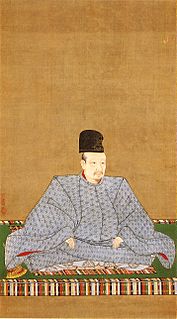
Emperor Go-Yōzei was the 107th Emperor of Japan, according to the traditional order of succession. Go-Yōzei's reign spanned the years 1586 through to his abdication in 1611, corresponding to the transition between the Azuchi–Momoyama period and the Edo period.

The Azuchi–Momoyama period is the final phase of the Sengoku period in Japan. These years of political unification led to the establishment of the Tokugawa shogunate. It spans the years from c. 1573 to 1600, during which time Oda Nobunaga and his successor, Toyotomi Hideyoshi, imposed order upon the chaos that had pervaded since the collapse of the Ashikaga shogunate.

Ishida Mitsunari was a Japanese samurai and military commander of the late Sengoku period of Japan. He is probably best remembered as the commander of the Western army in the Battle of Sekigahara following the Azuchi–Momoyama period of the 16th century. He is also known by his court title, Jibu-no-shō (治部少輔).

The Siege of Osaka was a series of battles undertaken by the Tokugawa shogunate against the Toyotomi clan, and ending in that clan's destruction. Divided into two stages, and lasting from 1614 to 1615, the siege put an end to the last major armed opposition to the shogunate's establishment. The end of the conflict is sometimes called the Genna Armistice, because the era name was changed from Keichō to Genna immediately following the siege.

The Council of Five Elders, was a group of five powerful feudal lords formed in 1598 by the Regent Toyotomi Hideyoshi, shortly before his death in the same year. While Hideyoshi was on his deathbed, his son, Toyotomi Hideyori, was still only 5 years old and as such Hideyoshi needed to create the council in order to ensure his heir would be able to succeed him after coming of age. They also acted as advisers for the Five Commissioners, which had also been established by Hideyoshi to govern Kyoto and the surrounding areas.

Oichi was a female historical figure in the late Sengoku period. She is known primarily as the mother of three daughters who married well – Yodo-dono, Ohatsu and Oeyo.
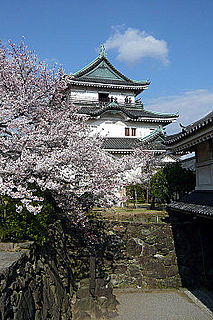
Wakayama Castle in Wakayama, Wakayama Prefecture, Japan, sits at the mouth of the Kii River. Originally Ōta castle, home of the Saiga Ikki, it was captured by Toyotomi Hideyoshi in 1585, during the Siege of Negoro-ji; many monks from Negoro-ji sought refuge in Ōta, which was soon destroyed by flood. Hideyoshi ordered the building of dams on three sides of the castle, focusing the rainwaters and diverting the river to ruin the castle. As hunger set in, the samurai, monks, and peasants inside Ōta surrendered, and fifty warrior monks led a final suicidal charge against Hideyoshi's army.

Yodo-dono (淀殿) or Yodogimi (淀君) was a prominently placed figure in late-Sengoku period. She was a concubine and second wife of Toyotomi Hideyoshi, who was then the most powerful man in Japan. She also became the mother of his son and successor, Hideyori. She was also known as Lady Chacha (茶々). After the death of Hideyoshi, she took the tonsure, becoming a Buddhist nun and taking the name Daikōin (大広院).

Senhime (千姫), or Lady Sen, was the eldest daughter of the shōgun Tokugawa Hidetada and later the wife of Toyotomi Hideyori. She was remarried to Honda Tadatoki after the death of her first husband. Following the death of her second husband, she later became a Buddhist nun under the name of Tenjuin (天樹院).
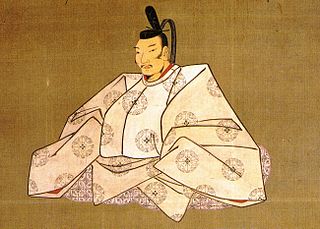
Toyotomi Hidetsugu was a daimyō during the Sengoku period of Japan. He was the nephew and retainer of Toyotomi Hideyoshi, the unifier and ruler of Japan from 1590 to 1598. Despite being Hideyoshi's closest adult, male relative, Hidetsugu was accused of atrocities and attempting to stage a coup after the birth of Hideyoshi's son, and he was ordered to commit suicide. Hidetsugu's entire family, including children, were also executed on Hideyoshi's orders. His death and that of his family contributed to the quick dissolution of Toyotomi authority after Hideyoshi's death three years later.
Toyotomi Kunimatsu was a member of the Japanese clan of Toyotomi following the Edo period of the 17th century. Kunimatsu was famed for being the son of Toyotomi Hideyori, who was the son of Toyotomi Hideyoshi. His mother was Hideyori's concubine, Icha (伊茶). In 1615 during the Siege of Osaka, Hideyori was defeated and committed suicide by seppuku, while his castle was taken by the forces of Tokugawa Hidetada and Tokugawa Ieyasu. Kunimatsu, who was seven years of age at the time, was captured by Tokugawa forces, and was later executed by decapitation.
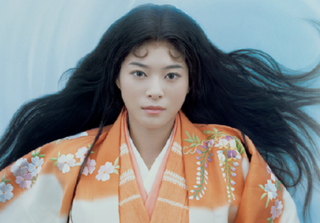
Gō: Hime-tachi no Sengoku (江〜姫たちの戦国〜) is a Japanese television series. It is the Taiga drama for 2011 and the 50th Taiga drama overall. It is written by Kumiko Tabuchi and stars Juri Ueno in the title role, with Miyazawa Rie and Mizukawa Asami.

Kōdai-ji, formally identified as Jubuzan Kōdai-ji, is a temple of the Rinzai school of Zen Buddhism in Higashiyama-ku, Kyoto, Japan—the largest subtemple of the Kennin-ji branch.

Shōkoku-ji (相国寺), formally identified as Mannen-zan Shōkoku Shōten Zenji (萬年山相國承天禅寺), is a Buddhist temple in northern Kyoto, founded in 1382 by Ashikaga Yoshimitsu.

Hōkō-ji is a temple in Kyoto, Japan, dating from the 16th century. Toyotomi Hideyoshi determined that the capital city should have a Daibutsu temple to surpass that of Nara. He is reputed to have claimed at the outset that he would complete construction in half the time it took Emperor Shōmu to complete the Great Buddha of Nara. The project during Emperor Shomū's reign took ten years. Hideyoshi would complete the initial phase of his project in only three years. The architects for this project were Nakamura Masakiyo and Heinouchi Yoshimasa.
Dokuganryū Masamune (独眼竜政宗) is a 1987 Japanese television series. It is the 25th NHK taiga drama. The broadcast received an average viewer rating of 39.7 percent in the Kanto area.
Kōzōsu (孝蔵主) was the daughter of Kawazoe Katsuhige, a retainer of the Gamō clan. She was an elite female officer under Nene's command and chief secretary to Toyotomi Hideyoshi. During the Toyotomi administration she possessed such authority that it was said that while Asano Nagamasa may run matters outside, Kōzōsu ran matters inside. She accompanied the Toyotomi clan in Japan's unification campaigns.
